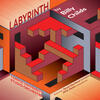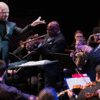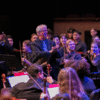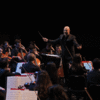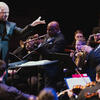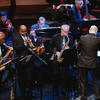Labyrinth by Billy Childs
Temple University Studio Orchestra
featuring
Terell Stafford, trumpet
Dick Oatts, saxophone
- Labyrinth by Billy Childs
- Red Braid by Banks Sapnar
- Rainforests by Bill Cunliffe
Labyrinth by Billy Childs is available for streaming and download on Apple Music, Spotify, Amazon, Pandora, Deezer and other services. Physical CDs are available for purchase on Bandcamp.
Labyrinth by Billy Childs
Labyrinth, a piece for big band, rhythm section and orchestra, was composed as a feature for Terell Stafford (trumpet) and Dick Oatts (alto saxophone). It is so titled because I was hoping to create a maze-like sense of imbalance through constantly shifting meters. I wanted the piece to start out feeling like it is in a triple meter (6/8 in this case), but actually being in multiple meters (6/8, 5/8, 2/4, and 9/8 in various configurations), thereby giving the listener, hopefully, a feeling of unpredictability while maintaining a logical continuum. So, the rhythm section starts out with this asymmetrically metered groove, with various chordal punctuations from the orchestra and big band. Terell and Dick then enter with a trumpet and alto sax melody that begins with a quartal phrase and is then followed by other melodic material – these melodic fragments are used later in shout choruses and tutti passages as a means to develop the piece.
A special challenge for me was to make big band, symphonic orchestra and small group with soloists congeal into an organic whole, from a sonic and orchestrational standpoint. So, in my mind, the big band took on the role of the symphonic brass and woodwind sections – at least in certain sections, like tutti passages, usually, where a lot of counterpoint and density was going on. I also included French horns, flutes and clarinets from the symphonic world because these instruments are very versatile sonically and blend well with other instruments.
Structurally, the piece is basically in two parts: the labyrinthine first part with the shifting meters, the trumpet solo section in 6/8 and the contrapuntal tutti section; and a slower, ballad-like section, which features the alto saxophone (later joined by the trumpet). This section ends with an intense build-up solo duet with trumpet and alto sax soloing together. This leads into a drum solo in 6/8, which then brings us back to the original “labyrinthine” opening section.
I want to offer a heartfelt thanks to Terell Stafford, Dick Oatts and Temple University for the honor of being commissioned to compose this piece.
--Billy Childs
Red Braid by Banks Sapnar
To me, Red Braid represents the love, joy and comfort that all of the amazing people in my life bring to me, and how that inspires me compositionally. Overwhelmingly inspired by a masterclass from bassist and composer John Clayton, I arranged this tune for the Temple University Jazz Band (TUJB) in one obsessive week, before bringing it into rehearsal to read. This piece was first performed at the TUJB winter concert at the Temple Performing Arts Center, then shortly after at Jazz at Lincoln Center’s Rose Hall for the band’s set at the Jack Rudin Jazz Championship. In the weeks leading up to the competition, the tune was workshopped and experimented with before becoming the final version it is today. Much of my musical inspiration for this arrangement came from some of my favorite big band composers such as Maria Schneider and Bob Mintzer, my love of modern American choral music, as well as modern jazz composers such as Pat Metheny, Billy Childs and Keith Jarrett.
Thanks to the work of my friends in the band, the piece is full of life that represents the creative spirit of the band as a whole. I am extremely grateful to Terell Stafford for the opportunity to hear and develop this composition, and to my fellow bandmates for putting their hearts and souls into my music and making it their own. Without them, the piece is just dots on a page: Their love is what makes it truly special.
I have some amazing people to thank for this piece, as I could not have done it without them. First, to Dick Oatts and Bruce Barth, my composition mentors at Temple who do an outstanding job of fostering an environment that is endlessly supportive to creativity and new ideas; to my trumpet teacher, Terell Stafford, for believing in my music, pushing and encouraging me, and giving me the opportunity to share my original music on these amazing stages; and my best friend and musical partner, Evan Kappelman, for his musicianship, advice, and for inspiring me to start composing in the first place. Thanks for listening and enjoy Red Braid!
--Banks Sapnar
Rainforests by Bill Cunliffe
For years, I’ve been intrigued by trees. Not only the trees in my neighborhood of Studio City, California, but the trees that keep us safe and healthy such as the tropical mangrove. Its tangle of roots allows the trees to handle the daily rise and fall of tides and slow the movement of tidal waters, causing sediments to build up the muddy bottom. The mangroves in the rainforests are truly the heart of our planet and help keep us alive. I’ve been thinking about them a lot, and the music of the tropics has always been a focus of mine, with the recordings I’ve done of Brazilian and Cuban music, samba and salsa.
Having three great horn soloists (Terell Stafford, Dick Oatts and Tim Warfield), a great piano soloist (Bruce Barth) and a fabulous symphony orchestra directed by José Luis Domínguez, one of our great conductors, meant I couldn’t go wrong.
The first movement starts with a large battery of percussion playing rainforest-like sounds in the style of a samba, the national dance of Brazil seen all year long, but especially during Mardi Gras, in the streets and barrios. The simple four-note melody is presented and twisted and turned by Tim Warfield in a variety of ways.
Movement two is a cross between a Mexican bolero and a Brazilian bossa, cast as a slow romantic movement. The great Dick Oatts presents the theme as a series of descending thirds, then improvises for a while. The movement ends with a cadenza featuring rainforest sounds as before, with the soloists adding bird calls and other exotic sounds.
Finally, the energetic street dance, but with added movements into meters of 5, 6 and 7, is stated by Terell Stafford and echoed by the orchestra. Hints of jazz big band figures lead into complex rhythmic figures you could get lost in like the rainforest! A transitional passage built on a Brazilian drum rhythm leads into the final climax, a batucada-like street dance as I saw in Rio so many years ago, but overlaid with jazz soloists and dissonant harmonies.
--Bill Cunliffe

